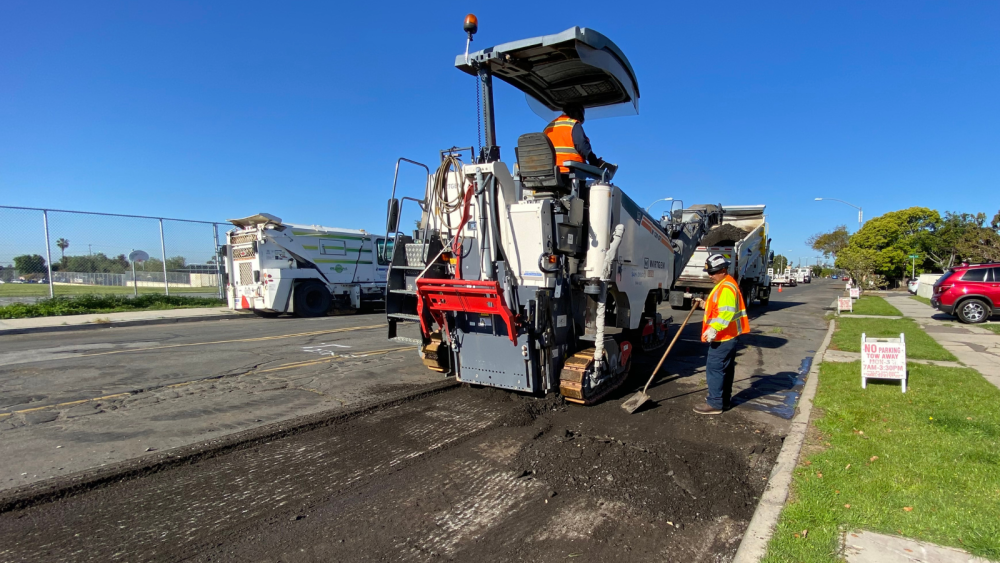Pavement Management Plan Provides Key Data on City of San Diego Road Conditions

Following a comprehensive condition assessment of every paved street segment in the City of San Diego, a long-awaited Pavement Management Plan outlines a data-driven strategy for pavement management across the City and identifies the need for long-term investment to maintain and improve San Diego’s vast network of roads.
Today, staff from the City’s Transportation Department will present the Pavement Management Plan to the City Council including a five-year plan that identifies specific streets and road repair that will be conducted citywide if funding is identified. The five-year plan is incorporated into StreetsSD, an interactive webpage that allows San Diegans to see ongoing and future paving projects in their neighborhoods, and to search information about individual streets.
"This crucial data gives us what we need to make informed strategic investments in our roads and the long-term plan on how to do that," said Mayor Todd Gloria. "What the Pavement Management Plan reveals is the need for major funding to reverse decades of neglect that allowed our street network to fall into serious disrepair. That’s the work that lies ahead."
The City first unveiled the Pavement Management Plan in January along with the results of the condition assessment, known as a Pavement Condition Index (PCI), in which the City scored 63 points, putting San Diego’s overall road network in the “Fair” category. PCI scores range from zero to 100 with a target network average of 70 being the industry standard.
During the data-gathering process, every mile of San Diego’s paved roadways was analyzed by lasers and other tools to measure pavement surface distress, such as cracks and potholes. Prior to this, the City performed its last road condition assessment in 2016, resulting in a PCI score of 71.
With a network of paved roads, alleyways and unimproved streets, the City of San Diego maintains more than 6,600 lane miles of roadway and has the second largest street network in California.
In the FY24 budget, Mayor Gloria dedicated a record $140 million investment to repair City streets by focusing on repairing San Diego’s high-volume roadways. In 2023, 254 miles of roadway were repaired or resurfaced, and more than 61,300 potholes were filled, a 94% increase over the prior year.
“Having this condition assessment data is crucial for our operations so that our team can be more strategic and cost-effective in allocating limited resources for road repair and maintenance,” said Bethany Bezak, Transportation Department Director. “What the Pavement Management Plan shows is that a significant investment is needed over the long term in order to prevent further deterioration of our roads and to bring San Diego’s PCI score closer to the industry standard where our residents expect us to be as the 8th largest city in the United States.”
The Pavement Management Plan points out that funding for road repair in the City has been inconsistent over the past 10 years and has been dependent on impacts to the City’s General Fund budget. Dedicated funding for road repair from state and county funding sources such as the Road Maintenance and Rehabilitation Account (RMRA) and TransNet are insufficient to keep up with necessary repairs. The City expects to receive approximately $52.1 million for road repair from these sources in fiscal year 2025. However, this is far less than the projected $227.8 million needed in fiscal year 2025 to ensure the City’s road network is maintained in good condition, meaning it would require an investment of $175.7 million from the General Fund.
Each year, road repair must compete with a multitude of other priorities for limited General Fund resources to close the remaining funding gap. The Pavement Management Plan points to the need for additional resources to provide a consistent, substantial investment in road repair on an annual basis.
A report released last week from the Office of the Independent Budget Analyst (IBA) confirmed the Pavement Management Plan takes a fiscally responsible approach to planning for future road repair and maintenance. When it comes to expanding the City’s current levels of road repair activity, the IBA report also analyzed the cost effectiveness of adding in-house repair crews to conduct some of the work currently done by contracted paving crews.
Due to space constraints identified at the Chollas Operations Yard, which currently houses crews from the Transportation, Stormwater and General Services departments, the IBA report recommends the City explore a potential new location to house Transportation crews in the future, along with a cost-benefit analysis on potential sites to ensure the efficient use of City resources.
The Transportation Department comprises nearly 500 employees including engineers, planners, equipment operators, electricians, technicians, field crews and management staff to service the City’s extensive public right of way. Of those, 110 staff are dedicated to maintaining and improving the City’s pavement condition, including nine in-house teams that conduct pothole repair, mill and pave work, trench restoration and engineering.
To view the complete Pavement Management Plan and to learn more about road repair in San Diego, visit the Pavement Management Plan page on the City’s website.
